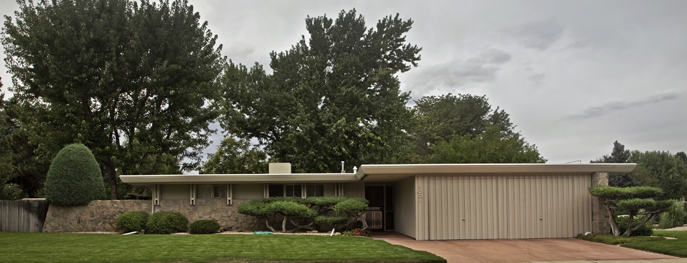
Arapahoe Acres was the first post-WWII subdivision listed as a National Register Historic District. Photo: Wayne Armstrong
The DU School of Architecture and Planning was only around for six years — 1946 to 1952 — but it left its modernist mark on south Denver.
Tucked away in a maze of side streets in Englewood, less than two miles from the DU campus, sits Arapahoe Acres, an astounding group of 124 mid-century modern homes right out of the Frank Lloyd Wright playbook.
The project was conceived in 1949 by Denver developer Edward Hawkins, who bought a 30-acre parcel of land for $5,250. For his architect, Hawkins chose Eugene Sternberg, a Czech-born professor at DU’s architecture school.
“Gene was very interested in this neighborhood for its social engineering,” says Arapahoe Acres resident and historian Diane Wray. “He wanted affordable homes, he was interested in the environmental aspect, and he was also very concerned that the houses be financially accessible to a variety of people, and also people at different stages in their lives.”
In 1998, thanks to Wray’s efforts, Arapahoe Acres became the first post-World War II subdivision listed as a National Register Historic District.
The end of World War II marked a huge housing boom in America. GIs were returning from abroad, wartime restrictions on manufacturing and construction were lifted, and new materials like plastics and synthetic resins were introduced into the market. Eager to capitalize on the trend, the Revere Copper and Brass Co. sponsored a national program encouraging modern design.
Hawkins and Sternberg applied and were accepted, and construction on Arapahoe Acres began in October 1949. The resulting neighborhood is like something out of “The Jetsons” or “77 Sunset Strip”: an oasis of contemporary design in a surrounding sea of middle-American split-levels and Cape Cods. Drawing from the International and Usonian styles — both related to the work of Wright — Arapahoe Acres abodes are all flat roofs, jutting eaves, low angles, large windows, flowing interiors and natural light.
“What’s so cool about Arapahoe Acres is that it’s kind of like driving into a little cocoon, like a time warp,” says Dana Cain (BA ’81), host of the annual Denver Modernism Show. “The street signs, the layout of it — you go in and you’re surrounded by it. It’s not like a lot of places where they have some good examples of mid-century architecture but they’re sitting next to this or that. When you’re in Arapahoe Acres, it’s complete immersion.”
The Hawkins-Sternberg partnership didn’t last long: After Hawkins sold a model home for more than the agreed-upon price, Sternberg left the project. About 20 homes in Arapahoe Acres were built on Sternberg’s plans. Hawkins assumed the design of the remaining homes, assisted by Gerry Dion, who had studied under Sternberg at DU.
In her Arapahoe Acres guidebook, Wray writes that the DU School of Architecture and Planning was discontinued in 1952 after the University of Colorado established a school of architecture in its college of engineering.
Modern architecture fell out of favor after the 1950s, due in part to FHA rules that required larger down payments for houses built as part of what the agency considered a fad. But with the recent resurgence of mid-century modern style, Arapahoe Acres has a new cachet among retro-minded Denverites.
“We love living in the house; it’s essentially like living in a piece of art,” says 10-year resident Dave Steers, who started his own business restoring and renovating mid-century homes shortly after moving to Arapahoe Acres. “We know a tremendous amount of people in the neighborhood because we all have the neighborhood in common.”
Even those not lucky enough to live there are welcome to walk, drive or bicycle through — perhaps as part of a south Denver mid-century tour that also includes nearby enclaves Krisana Park, Arapaho Hills and Mile High.
“It’s like a little slice of paradise; it’s a total gem,” Cain says. “I would give anything to live there.”
